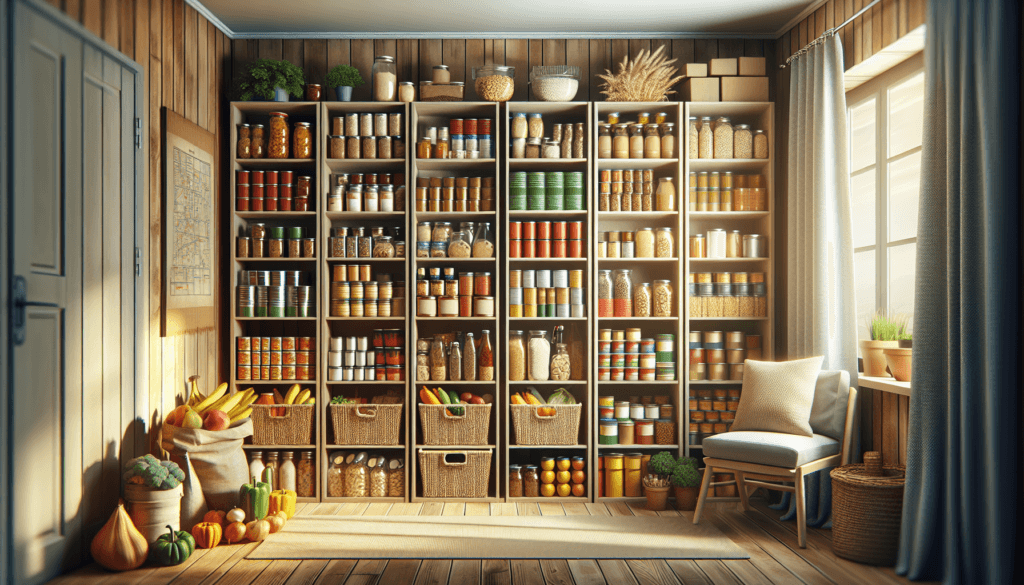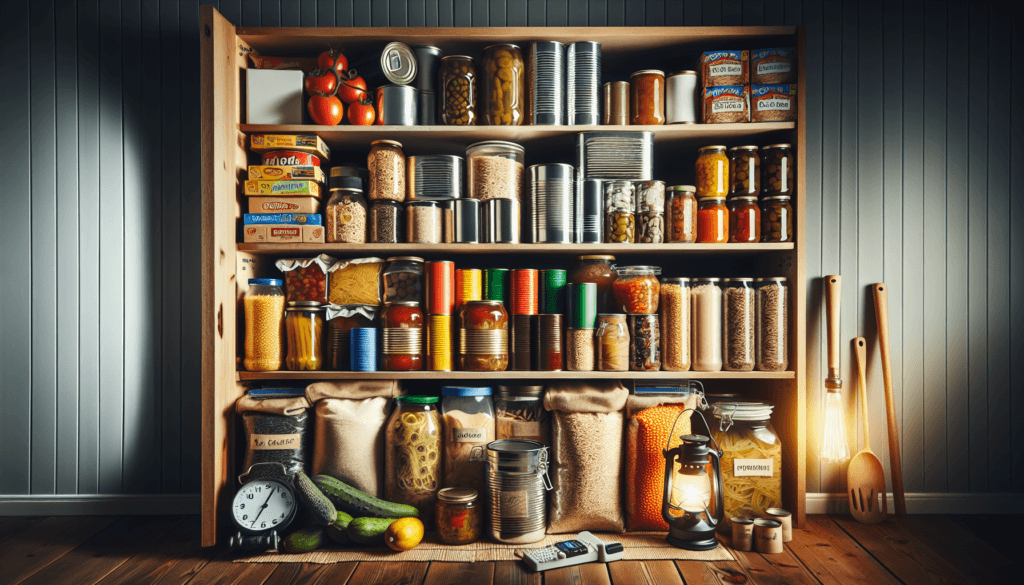In this article, you will discover the essential steps to building a food storage pantry for emergencies. Whether you are preparing for natural disasters, power outages, or unexpected events, having a well-stocked pantry can provide peace of mind and ensure the well-being of you and your loved ones during challenging times. From determining your storage needs to selecting the right foods and organizing your pantry, this guide will walk you through the entire process, allowing you to feel prepared and confident in the face of any emergency. So, let’s begin!

Key Considerations
Assessing your needs and goals
When building a food storage pantry for emergencies, it’s essential to start by assessing your specific needs and goals. Consider factors such as the number of people in your household, including any infants or pets, and their dietary requirements. Think about whether you have any specific health concerns or allergies that need to be taken into account. By understanding your needs and goals, you can ensure that your emergency food supply is tailored to meet those requirements.
Calculating the required supply
Once you have assessed your needs, the next step is to calculate the required supply of food. Determine how long you want your food storage pantry to sustain you and your household in case of an emergency. It is generally recommended to have at least a three-day supply of food, but for more substantial emergencies, a two-week or even three-month supply might be necessary. Consider the number of meals per day and the caloric intake required for each person to adequately sustain themselves.
Determining storage space
Before stocking your food storage pantry, it’s essential to consider the available storage space. Assess the area in your home that can be designated for storing emergency food supplies. Make sure it is a cool, dry, and well-ventilated space, as these conditions help preserve the quality and shelf life of the stored food. Consider utilizing shelves, cabinets, or even a separate room if you have the available space. Adequate storage space is crucial to organize and rotate your food supply effectively.
Considering nutritional requirements
When building your food storage pantry, it is crucial to consider the nutritional requirements of yourself and your household. Aim for a well-balanced and diverse supply of foods that provide essential nutrients. Incorporate a variety of grains, proteins, fruits, vegetables, and fats. Pay attention to the nutritional needs of children, pregnant or nursing individuals, and those with specific dietary restrictions. By choosing foods that provide a range of nutrients, you can ensure adequate nutrition during an emergency situation.
Choosing the Right Foods
Stocking non-perishable goods
One of the key considerations when building an emergency food supply is to stock up on non-perishable goods. Non-perishable foods have a longer shelf life and can safely be stored for an extended period. Examples include canned goods, dried fruits, nuts, and grains. These items do not require refrigeration and can withstand temperature fluctuations. Make a list of non-perishable foods that your household regularly consumes and aim to stock up on those items.
Selecting healthy and balanced options
While building your emergency food supply, it is essential to select healthy and balanced food options. Opt for whole grains, such as brown rice and quinoa, which provide more nutrients than refined grains. Include canned fruits and vegetables that retain their nutritional value. Look for low-sodium or no-added-sugar options. Choose healthier sources of protein, such as canned fish or beans. By focusing on nutritious options, you can ensure that your emergency food supply supports your overall well-being.
Taking individual dietary restrictions into account
When building an emergency food supply, it’s important to consider individual dietary restrictions. Take into account any food allergies, intolerances, or special diets that members of your household may have. Stock up on suitable alternatives that meet their specific needs. Consider gluten-free options, dairy-free alternatives, and vegetarian or vegan choices. By taking individual dietary restrictions into account, you can ensure that everyone has access to suitable and safe food during an emergency situation.
Considering long shelf life and versatility
Another crucial factor to consider when choosing foods for your emergency pantry is their shelf life and versatility. Aim for foods that have a long shelf life, as it ensures they will remain edible and nutritious for an extended period. Dried beans, rice, and pasta are excellent options as they can be stored for years. Additionally, consider foods that can be used in a variety of recipes and meals. Versatile ingredients like canned tomatoes, broth, and spices can enhance the flavors of different dishes and add variety to your emergency meals.

Building a Basic Emergency Food Supply
Start with water
Before focusing on food, it is vital to prioritize water in your emergency food storage pantry. Water is essential for hydration and various other needs during an emergency. The general rule of thumb is to store at least one gallon of water per person per day. This includes water for drinking, cooking, and basic hygiene. Ensure the water containers are food-safe and placed in a cool, dark area to prevent bacterial growth. It’s also a good idea to have water purification tablets or a filtration system as a backup plan.
Include canned fruits and vegetables
Canned fruits and vegetables are a valuable addition to your emergency food supply. They provide essential vitamins, minerals, and fiber. Opt for fruits canned in water or their juice, rather than sugary syrups. Look for vegetables with no added salt to ensure a healthier choice. Canned produce retains its nutritional value and can be conveniently incorporated into meals or eaten as standalone snacks. Aim to have a variety of fruits and vegetables to add flavor, essential nutrients, and dietary diversity.
Stock up on grains and cereals
Grains and cereals are staple food items that can provide carbohydrates, fiber, and energy during an emergency. Stock up on durable options like oats, rice, pasta, and quinoa. These items can be stored for a long time and can be prepared in a variety of ways. Consider individual preferences and dietary restrictions when selecting the types of grains and cereals to stock. Having a variety of options will help provide different textures and flavors to meals, ensuring they do not become monotonous.
Add protein sources
Protein is an essential nutrient for maintaining energy and muscle mass during emergencies. Include protein sources such as canned fish, chicken, or beans in your emergency food supply. These options provide a longer shelf life and can be easily incorporated into various meals. Consider selecting different types of protein to cater to individual preferences and dietary needs. Protein-packed options like peanut butter, nuts, and protein bars can also be great additions to your emergency food supply.
Don’t forget about fats and oils
Fats and oils are crucial for a well-balanced diet and can be beneficial during emergencies. Include options like olive oil, vegetable oil, or coconut oil in your emergency food storage pantry. These items can be used for cooking and food preparation, as well as providing necessary fats. Additionally, having individually packaged items like nut butters or trail mix can provide a quick source of energy and healthy fats during an emergency. Remember to store these items in a cool, dark place to prevent spoilage.
Include sweeteners, spices, and seasoning
To add flavor and variety to your emergency meals, it’s important to include sweeteners, spices, and seasoning. Stock up on items such as salt, pepper, herbs, and spices to enhance the taste of your food. Sweeteners like honey or maple syrup can be used as an alternative to sugar. Consider including condiments like ketchup, mustard, and soy sauce to make your meals more enjoyable. These small additions can make a significant difference in the overall taste and satisfaction of your emergency meals.
Consider providing infant formula or pet food if needed
If you have infants or pets in your household, it’s crucial to ensure their needs are met during an emergency as well. Stock up on an appropriate supply of infant formula, bottles, and baby food if necessary. Make sure to consider the expiration dates and rotate these items regularly. Similarly, ensure you have an adequate supply of pet food for your furry companions. By including these items in your emergency food storage, you can ensure the well-being of all members of your household.
Expanding Your Food Storage
Gradually increasing the supply
Once you have built a basic emergency food supply, it’s important to consider gradually increasing the supply over time. Building a comprehensive food storage pantry takes time and effort, so start by adding a few extra items during each trip to the grocery store. Gradually expand your supply by including additional non-perishable goods, such as canned meats, preserved fruits, and vegetables, or shelf-stable dairy products. By consistently adding to your stockpile, you can create a more robust and sustainable emergency food supply.
Incorporating freeze-dried and dehydrated foods
To enhance the variety and longevity of your emergency food supply, consider incorporating freeze-dried and dehydrated foods. These options have an extended shelf life and are lightweight, making them ideal for emergency situations. Freeze-dried vegetables, fruits, and meats can be rehydrated with water to restore their original texture and flavor. Dehydrated foods like dried fruits and jerky are convenient, nutrient-dense snacks. Including these items in your food storage pantry can provide additional options and nutritional variety during an emergency.
Including ready-to-eat meals and MREs
Ready-to-eat meals (RTEs) and Meals Ready-to-Eat (MREs) are valuable additions to consider for your emergency food supply. These pre-packaged meals come in sealed pouches and are designed to be consumed without additional cooking or preparation. They often include a main dish, side items, and even dessert. RTEs and MREs are a convenient option for emergency situations when cooking facilities may be limited or unavailable. They provide a well-balanced meal that is ready to eat, giving you quick and hassle-free sustenance.
Storing bulk staples like rice, pasta, and beans
As you expand your food storage pantry, it’s wise to consider including bulk staples like rice, pasta, and beans. These items offer a cost-effective and sustainable source of calories and nutrients. Purchase these staples in larger quantities to take advantage of cost savings. It’s important to properly store these bulk items in airtight containers to prevent spoilage and infestation. When stored correctly, these staples can last for an extended period, providing you with a reliable source of sustenance during an emergency.

Organizing and Rotating Stock
Implementing a first-in, first-out system
To maintain the freshness and quality of your emergency food supply, it is essential to implement a first-in, first-out (FIFO) system. This means using the oldest items in your stockpile before newer ones. When replenishing your pantry, add new items to the back and bring older items forward. By following this system, you ensure that your food supply remains fresh and consumed within their recommended expiration dates.
Properly labeling and dating items
To effectively manage your food storage pantry, it’s crucial to properly label and date each item. Use permanent markers or labels to indicate the contents of each container or package. Clearly write the purchase or expiration dates to identify when each item was added to your supply. This labeling system helps you keep track of the age and quality of your stored food, making it easier to rotate your stock and minimize waste.
Regularly assessing and updating inventory
Maintaining an up-to-date inventory of your emergency food supply is vital. Regularly assess your stockpile to identify any expired or damaged items. Remove these items from your pantry and replace them as needed. Take note of items that are frequently consumed and consider replenishing them in larger quantities. By regularly assessing and updating your inventory, you ensure that your emergency food supply remains fresh, safe, and reliable.
Creating a storage system
To keep your emergency food storage organized and easily accessible, it’s important to create a storage system. Use sturdy shelves, bins, or cabinets to separate different food categories. Group similar items together, such as canned goods, grains, and proteins. Consider using clear storage containers, allowing you to easily identify the contents inside. Keep heavier items on lower shelves to prevent accidents or injuries. By creating a dedicated and organized storage system, you can quickly locate and manage your emergency food supply.
Storing and Preserving Food
Finding suitable containers
When storing your emergency food supply, it’s essential to use suitable containers. Opt for airtight, food-grade containers that are resistant to moisture, pests, and odors. Plastic containers with secure lids are commonly used for this purpose. Glass jars with tight-fitting lids can also be a good option, as they are non-reactive and do not absorb odors. Avoid using containers that have previously held non-food items, as they can contaminate the stored food. Remember to label each container with its contents and expiration dates for easy organization.
Using appropriate packaging materials
Some foods, especially bulk staples, may need additional packaging materials to ensure long-term storage. For items like rice, pasta, and beans, consider using mylar bags or food-grade plastic buckets with gamma lids. These materials provide an extra layer of protection against moisture, pests, and air exposure. Vacuum-sealed bags can also be used to remove excess air and prolong the shelf life of certain foods. Be sure to store these packaged foods in a cool, dry place to maintain their quality.
Consider vacuum sealing and oxygen absorbers
To further extend the shelf life of certain foods, consider using vacuum sealers and oxygen absorbers. Vacuum sealing removes air from the packaging, creating a barrier against moisture and oxygen, which can lead to spoilage. This method is particularly effective for dehydrated or freeze-dried foods. Oxygen absorbers are small packets that contain iron powder, which absorbs oxygen from the surrounding environment. When used in conjunction with vacuum sealing or mylar bags, they can help prevent oxidation and maintain food quality.
Ensuring proper temperature and humidity levels
Temperature and humidity levels play a crucial role in preserving the quality and shelf life of your emergency food supply. Aim to store your food in a cool, dry place with a consistent temperature between 50-70°F (10-21°C). Avoid areas with extreme temperature fluctuations, such as attics or garages, as they can negatively impact the stored food. Excessive heat and high humidity can accelerate the spoilage process and promote the growth of bacteria, mold, and insects. Proper storage conditions are essential for maintaining the nutritional value and safety of your emergency food supply.

Location and Accessibility
Identifying a suitable storage location
When determining the location for your emergency food storage, it’s important to consider various factors. Choose a space that is away from direct sunlight, as exposure to sunlight can deteriorate the quality of certain foods and containers over time. Consider utilizing areas like basements, pantries, or closets as they typically replicate the ideal cool and dark storage conditions. Ensure the chosen location is easily accessible to you and your household members, allowing for efficient retrieval and rotation of food items.
Considering ease of access
During emergencies, quick and easy access to your emergency food supply is crucial. Make sure your storage location is easily accessible to all household members, including those with mobility challenges. Arrange shelves and containers in a way that allows you to reach items without difficulty. Consider using clear storage containers or labeling systems to quickly identify specific foods when needed. By optimizing accessibility, you can minimize stress and ensure smooth access to your emergency food supply.
Ensuring the area is cool and dry
Proper temperature and humidity control are essential to maintain the quality and longevity of your emergency food supply. Ensure the chosen storage area remains cool and dry throughout the year. Avoid locations prone to moisture, such as areas near plumbing or windows. Install a dehumidifier if necessary to maintain the appropriate humidity level. By creating and maintaining a cool and dry environment, you can significantly extend the shelf life of your emergency food items.
Protecting from pests and sunlight
When selecting a storage location, it’s crucial to protect your emergency food supply from pests and sunlight. Ensure the area is well-sealed to prevent insects and rodents from accessing your stored food. Use pest control measures such as traps or repellents if necessary. Avoid storing your food supply in areas prone to direct sunlight, as ultraviolet rays can degrade the quality and nutritional value of many foods. By taking steps to safeguard your emergency food supply, you can ensure it remains safe and usable when needed.
Emergency Preparedness Beyond Food
Including other essential supplies
While food is an important component of emergency preparedness, it should not be the only focus. It’s crucial to include other essential supplies in your emergency preparedness plan. These supplies may include drinking water, medicine, personal hygiene items, batteries, flashlights, a first aid kit, and blankets. Think about the specific needs and comfort requirements of your household members, and ensure you have the necessary supplies to meet those needs during an emergency.
Maintaining emergency kits
Emergency kits are an integral part of being prepared for various situations. Consider assembling emergency kits for each member of your household, including items like a change of clothes, medication, a flashlight, and a portable radio. Additionally, keep a larger emergency kit that includes essential tools, a fire extinguisher, and a whistle in case you need to signal for help. Regularly check and refresh the contents of these kits, ensuring they are ready to be used in case of an emergency.
Focusing on medical and sanitation needs
In addition to food and general supplies, addressing medical and sanitation needs is vital for comprehensive emergency preparedness. Ensure you have a well-stocked first aid kit that includes essential medications, bandages, and disinfectants. Consider any ongoing medical requirements and ensure you have an adequate supply of prescribed medications. Plan for sanitation needs by having a sufficient quantity of hygiene products, including toilet paper, hand sanitizer, and cleaning supplies. By addressing these critical aspects, you can better prepare for emergencies and ensure the well-being of your household.

Maintaining and Updating Your Pantry
Replenishing and rotating stock regularly
Maintaining a well-stocked emergency food pantry requires regular replenishment and rotation of stock. Keep track of the expiration dates of each item and make it a habit to check your pantry periodically. Regularly consume and replace foods that are approaching their expiration dates. When shopping for everyday groceries, consider purchasing extra quantities of non-perishable items to replenish your emergency food supply. By staying consistent with this process, you can ensure that your pantry remains fresh and ready for any emergencies.
Monitoring expiration dates
Expiration dates are crucial indicators of a food item’s freshness and safety. Make it a routine to monitor the expiration dates of the products in your emergency food pantry. Keep a record or use a digital tracking system to help you manage and monitor the dates effectively. As items near their expiration dates, plan meals that incorporate those products to prevent waste. Regularly review and rotate your stock to ensure your emergency food supply remains safe and of high quality.
Updating based on changing needs and circumstances
As time goes on, your needs and circumstances may change, and it’s important to update your emergency food supply accordingly. Review your pantry regularly and consider any dietary changes, new family members, or changes in individual preferences. Assess your storage space and adjust your stockpile to accommodate any changes. Stay aware of new recommendations or guidelines from emergency preparedness experts to ensure your pantry remains up to date and relevant.
Seeking Expert Advice
Consulting with emergency preparedness professionals
When building a food storage pantry for emergencies, it can be beneficial to consult with emergency preparedness professionals. These experts can provide valuable guidance and recommendations based on their experience and knowledge. Seek advice from local government agencies or organizations dedicated to disaster preparedness. They can offer specific insights regarding your region’s risks, recommended supplies, and storage practices. By consulting with professionals, you can ensure your food storage pantry is optimized for your unique emergency preparedness needs.
Reaching out to nutritionists and dietitians
Nutritionists and dietitians can offer valuable insight into ensuring the nutritional adequacy of your emergency food supply. They can guide you on selecting foods that meet the dietary requirements of different age groups, health conditions, and dietary restrictions. Consult with a nutrition professional to discuss any concerns or questions you may have regarding the nutritional content and balance of your emergency food supply. With their expertise, you can make informed choices and provide the necessary nutrients during an emergency.
Joining online communities for ideas and suggestions
Joining online communities focused on emergency preparedness can provide a wealth of ideas and suggestions for building a food storage pantry. Engaging with a community of like-minded individuals allows you to benefit from their experiences and learn from their mistakes or successes. You can find tips, recipes, and recommendations specific to emergency preparedness. Online platforms, forums, and social media groups dedicated to this topic can connect you with a community eager to share knowledge and support. By tapping into these resources, you can enhance your food storage pantry and emergency preparedness efforts.
In conclusion, building a food storage pantry for emergencies requires careful consideration of your needs, goals, and available resources. By assessing your requirements, calculating the necessary supply, and determining suitable storage space, you can establish a foundation for your emergency food supply. Selecting the right foods, organizing and rotating stock, and ensuring proper storage conditions are critical for maintaining a well-stocked pantry. Additionally, addressing other essential supplies, focusing on medical and sanitation needs, and seeking expert advice contribute to comprehensive emergency preparedness. With the right planning and continuous maintenance, you can build a reliable food storage pantry that provides peace of mind and sustenance during unexpected situations.


